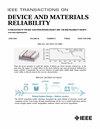Analysis of Trapping Mechanisms and Capacitance Dispersion in Double-π Gate AlGaN/GaN HEMTs Under High-Temperature Conditions
IF 2.3
3区 工程技术
Q2 ENGINEERING, ELECTRICAL & ELECTRONIC
IEEE Transactions on Device and Materials Reliability
Pub Date : 2025-03-16
DOI:10.1109/TDMR.2025.3570841
引用次数: 0
Abstract
High-temperature dc and ac capacitance dispersion analysis of the double-高温条件下双π栅AlGaN/GaN hemt的俘获机理和电容色散分析
对双$\pi $栅极AlGaN/GaN高电子迁移率晶体管(HEMT)的高温直流和交流电容色散进行了仿真分析,分析了捕获效应。电子器件中的自热现象会降低性能和使用寿命。自热效应(SHE)导致通道温度升高,直接影响带隙(EG)、电子迁移率($\mu _{e}$)、电子饱和速度(Vsat)、阈值电压(VTH)、击穿电压(VBD)、跨导(gm)、漏极饱和电流(IDS)、输出功率(Pout)以及记忆效应和噪声性能。为了减轻自热效应,设计了一种新的双$\pi $门HEMT,门杆分为三柱。这种结构重新分配电场,减少声子散射。值得注意的是,在高温下工作时,器件的电流损耗(CC)百分比大大降低。电容色散模拟使用二维TCAD在环境温度范围从253°K到1098°K。模拟结果表明,在极端温度下,热电子产生和俘获效应最小。当温度高于773°K时,栅杆距离大于150 nm时,观察到轻微的扭结效应。
本文章由计算机程序翻译,如有差异,请以英文原文为准。
求助全文
约1分钟内获得全文
求助全文
来源期刊

IEEE Transactions on Device and Materials Reliability
工程技术-工程:电子与电气
CiteScore
4.80
自引率
5.00%
发文量
71
审稿时长
6-12 weeks
期刊介绍:
The scope of the publication includes, but is not limited to Reliability of: Devices, Materials, Processes, Interfaces, Integrated Microsystems (including MEMS & Sensors), Transistors, Technology (CMOS, BiCMOS, etc.), Integrated Circuits (IC, SSI, MSI, LSI, ULSI, ELSI, etc.), Thin Film Transistor Applications. The measurement and understanding of the reliability of such entities at each phase, from the concept stage through research and development and into manufacturing scale-up, provides the overall database on the reliability of the devices, materials, processes, package and other necessities for the successful introduction of a product to market. This reliability database is the foundation for a quality product, which meets customer expectation. A product so developed has high reliability. High quality will be achieved because product weaknesses will have been found (root cause analysis) and designed out of the final product. This process of ever increasing reliability and quality will result in a superior product. In the end, reliability and quality are not one thing; but in a sense everything, which can be or has to be done to guarantee that the product successfully performs in the field under customer conditions. Our goal is to capture these advances. An additional objective is to focus cross fertilized communication in the state of the art of reliability of electronic materials and devices and provide fundamental understanding of basic phenomena that affect reliability. In addition, the publication is a forum for interdisciplinary studies on reliability. An overall goal is to provide leading edge/state of the art information, which is critically relevant to the creation of reliable products.
 求助内容:
求助内容: 应助结果提醒方式:
应助结果提醒方式:


